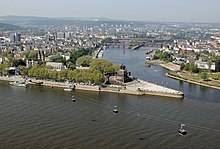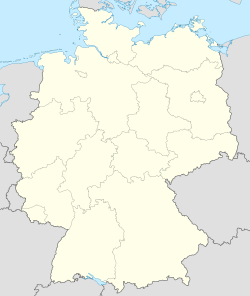| Koblenz Koblenz | ||
 | ||
Coat of arms and flag  | ||
| State | Germany | |
|---|---|---|
| Federated state | Rhineland-Palatinate | |
| Altitude | 73 m a.s.l. | |
| Surface | 105 km² | |
| Inhabitants | 112.586 (2015 census) | |
| Prefix tel | 49 261, 2606 | |
| POSTAL CODE | 56068–56077 | |
| Time zone | UTC 1 | |
Position
| ||
| Institutional website | ||
Koblenz (Koblenz, in FrenchCoblence) is a city of the Rhineland-Palatinate, federated state of the Germany.
To know
Geographical notes
Koblenz is located at the point where the Rhine receives the waters of the Moselle. Only the old town and the adjacent neighborhoods stand on a small plain. The rest of the territory is quite rugged, bordered to the south by the Hunsrück hills and to the west by those of Maifeld, advertised for tourism purposes as the "Tuscany of Germany". The east bank of the Rhine dominated by the Ehrenbreitstein fortress is also quite steep. Tourists reach the fortress from the center with a cable car that crosses the river.
Background
Koblenz is one of the oldest German cities. In 9 BC the Roman legions established a camp there and called it Confluentes with reference to its geographical position, at the confluence of the Rhine with the Moselle. Very few traces remain of the Roman era. Only the excavations in 2011 in the basement of the basilica of San Castore were able to accurately identify the place where the Roman camp stood.
After the withdrawal of the Roman legions, Koblenz fell into the hands of the Franks who made it a royal residence. In 842 a meeting was held in the Basilica of San Castore in which the dividing lines of the empire created by Charlemagne between his sons Ludovico il Pio, Lotario I, Carlo il Calvo and Ludovico II were defined. The agreement was then ratified by the Verdun treaty the following year.
From the 10th century until the outbreak of the French Revolution, Koblenz was a possession of the archbishops of Trier. The first bishops were responsible for the raising of numerous churches, castles and fortresses. They rebuilt the Roman wooden bridge over the Moselle, known today as Balduinbrücke (Baldovino bridge). The first fortress of Ehrenbreitstein, considered impregnable, dates back to 1020. The castle of Stolzenfels on the Rhine dates back to 1259, used to collect customs duties imposed on river navigation which ensured substantial income for the bishops of Trier. L' high Burg (old castle) was completed in 1276 to house a military garrison that had the task of curbing the aspirations of citizens to forms of autonomous government.
During the Thirty Years War the bishops abandoned Trier and settled in Koblenz, deemed safer from French attacks. From 1632 to 1786, the Prince Archbishops lived in Philippsburg Castle, a magnificent Baroque complex on the bank of the Rhine, blown up by French revolutionary troops together with the towering Ehrenbreitstein fortress.
The last Prince Archbishop, Clement Wenceslas of Saxony, commissioned French architects to build a magnificent palace on the bank of the Rhine. He took possession of it in 1786 but was forced to abandon it eight years later, under the pressure of the French revolutionary army. .
The congress of Vienna of 1815 chaired by Metternich, a native of Koblenz, assigned the possession of the prince archbishops to the kingdom of Prussia. King Frederick William IV had the castle of Stolzenfels rebuilt, destroyed by the French in 1689. His successor William, proclaimed first emperor of Germany in 1871, stayed for a long time in the fairytale castle with his wife Augusta. In his memory the equestrian monument was erected at the confluence of the Moselle and Rhine rivers, which today is a symbol of the city.
In 1858 the first railway arrived in Koblenz, determining its economic development. In 1890 the walls were demolished to allow urban extension.
Koblenz was occupied by French troops in both periods following World War I and World War II. In 1946 the city became the provisional capital to replace Mainz of the state Rhineland-Palatinate, created by the French. In that year the population was reduced to about 50,000 inhabitants, half of the pre-war period. Only in 1962 did it reach more than 100,000 inhabitants. The city looked like a heap of ruins but many of its historic buildings were rebuilt according to their original design.
How to orient yourself
How to get
By plane
- Frankfurt International Airport (FRA).
- Cologne Bonn Airport (CGN).
- Frankfurt Hahn Airport (HHN).
On the train
- 1 Koblenz Central Station (Koblenz Hauptbahnhof).
How to get around
What see
Monuments and points of interest

- 1 Deutsches Eck, Konrad-Adenauer-Ufer, ☎ 49 261 19433.
- 2 Schängelbrunnen.
- 3 Historiated column (Historiensäule), Josef-Görres-Platz.
- 4 Four towers (Vier Türme).
- 5 Baldovino Bridge (Balduinbrücke).
- 6 Mosellum (Moselstaustufe), Peter-Altmeier-Ufer 1.
 €3.
€3.  Tue-Sun 10 am-5pm.
Tue-Sun 10 am-5pm.
Civil and military architectures
- 7 Town Hall (Rathaus). Monument to Johannes Mueller.
- 8 Ehrenbreitstein Fortress (Festung Ehrenbreitstein), ☎ 49 261 667 54000. On top of a hill overlooking the east bank of the Rhine, the Ehrenbreitstein fortress can be reached by cable car from the center. Inside are the collections of the state museum shown later.
- 9 Palace of the Electors (Kurfürstliches Schloss), Schloßstraße. the Castle of the Electors of Trier, built from 1777 to 1793 and now used for temporary exhibitions. It can be visited only on the occasion of events.
- 10 Old castle (Alte Burg), Burgstraße 1, ☎ 49 261 1292641.
- 11 Stolzenfel Castle (Schloss Stolzenfels), Schlossweg, ☎ 49 261 51656.
Religious architectures
- 12 Basilica of San Castore, Kastorhof 4, ☎ 49 261 31550.
- 13 Liebfrauenkirche, An der Liebfrauenkirche 16, ☎ 49 261 31550.
- 14 Jesuit church of S. Giovanni Battista (Jesuitenkirche St. Johannes der Täufer), Jesuitenplatz 4, ☎ 49 261 912630.
- 15 Church of the Heart of Jesus (Herz-Jesu-Kirche), Löhrrondell 1A.
- 16 Church of San Florin (Florinskirche), Florinsmarkt 23. Erected in the mid-first millennium, it was rebuilt in 1100 in Romanesque style and dedicated to St. Florin. In the mid-15th century the apse was rebuilt in the Gothic style. Secularized in 1802, it has belonged to the Evangelical Church in Germany since 1820.
Museums

- 17 Federal Archives, Potsdamer Straße 1. Collections of documents relating to the history of Germany. Among other things, there are models of the projects relating to the urban plan of Berlin drawn up by Hitler's architect Albert Speer, which were only partially completed.
- 18 Koblenz State Museum (Landesmuseum), ☎ 49 261 66750. Museum set up inside the Ehrenbreitstein fortress. Founded in 1956 as a state collection for prehistory and folklore, the collections are dedicated to photography, archeology, viticulture, cultural and economic history.
- 19 Romantikum, Zentralplatz 1, ☎ 49 261 1291610.
- 20 Mittelrheinmuseum, Zentralplatz 1, ☎ 49 261 1292520.
- 21 Rhenish Museum (Rhein-Museum), Charlottenstraße 53A, ☎ 49 261 703450.
- 22 Ludwig Museum (Ludwig Museum im Deutschherrenhaus), Danziger Freiheit 1, ☎ 49 261 304040.
- 23 Collection of defensive techniques (Wehrtechnische Studiensammlung Koblenz), Mayener Str. 85, ☎ 49 261 9836921423. Military Museum.
- 24 DB Museum, Schönbornsluster Str. 14, ☎ 49 261 3961338.
- 25 Birthplace of Metternich (Haus Metternich), Münzplatz 7, ☎ 49 261 2016888.
- 26 Beethoven's Mother House (Mutter-Beethoven-Haus), Wambachstraße 204, ☎ 49 261 9730669.
Parks
- 27 Lungoreno (Rheinanlagen).
Events and parties
What to do
Shopping
How to have fun
Night clubs
- 1 Agostea, Clemensstraße 26-30, ☎ 49 261 9738533. Dance club.
- 2 Palais, Firmungstraße 2, ☎ 49 261 92139920. Club / brewery.
- 3 Irish Pub Koblenz, Burgstraße 7, ☎ 49 261 97381388.
- 4 Spökes, Weißer Gasse 19-25, ☎ 49 261 29671819.
- 5 Gecko, Gemüsegasse 14a, ☎ 49 261 1004334. Cocktail bar.
- 6 Zenit Club, Poststraße 2A, ☎ 49 261 92179902. Cocktail bar that after a certain hour turns into a disco frequented by students and young men, becoming more and more dirty and suffocating with the passing of the hours.
- 7 Kurioos, Altenhof 5, ☎ 49 261 28732451.
 Mon-Sat 18: 00-06: 00 Sun 18: 00-01: 00. Gay club.
Mon-Sat 18: 00-06: 00 Sun 18: 00-01: 00. Gay club. - 8 [link previously not working]Fox Koblenz, Altenhof 15, ☎ 49 261 8761766. Gay, lesbian, joint club.
Where to eat
Moderate prices
- 1 Thai thai Asia Bistro, Löhrstraße 141, ☎ 49 261 29350883.
- 2 Königsbacher Treff, Löhrstr. 143, ☎ 49 261 97384949. Cafe / bistro, German cuisine.
- 3 Baristaz, Schloßstraße 45, ☎ 49 261 97359550.
- 4 Semano's, Firmungstr. 26, ☎ 49 261 9423244. Pasta, pizza, desserts.
- 5 Akropolis - Grill, Hohenzollernstr. 130.
- 6 Gretchens, An der Liebfrauenkirche 17, ☎ 49 261 9144657.
Average prices
- 7 Weindorf, Julius-Wegeler-Straße 2, ☎ 49 261 133 7190.

